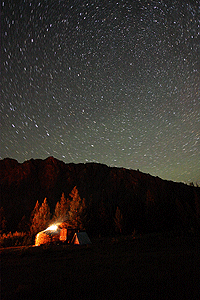 |
 |
 |
 |
|
Airglow, Kurai Steppe, Altay Republic, Russia by Koen van Gorp (site, larger animation). ©Koen van Gorp, shown with permission. "During my trip to Siberia to observe the August 1, 2008 total solar eclipse we stayed in a number of extremely dark places. Because of the nature of the trip I didn't have much equipment with me save what was needed to image the eclipse and the spectacular landscape of the Altay Mountains. To profit from these superb skies I did some star trail images, but one rather surprised me when I looked at the images at home." The slowly moving green bands backed by the majestically wheeling stars are airglow. In daytime the sun's extreme ultra-violet radiation excites atoms and molecules high in the thermosphere. Airglow is the light emitted when the excitation is slowly released. Airglow comes in several colours, the green light here is from oxygen atoms 90 - 100 km (56 to 62 miles) high. Below that level there is less UV radiation. The pressure is also greater and any excited atoms are de-excited more quickly by collisions with other atoms and molecules. The narrow layer is clearly seen from earth orbit (lower image). Airglow is often banded by the action of gravity waves propagating upwards from lower atmospheric levels. The waves modulate the excitation transfer and collisional quenching rates and thus the glow intensity. Airglow can just be seen by eye in very favourable conditions - "I did notice that the sky was not completely dark - even if the nearest village was 25km away. Clouds appeared as dramatic black blotches over the star filled sky. Maybe I observed airglow in this manner." |
 |
 |
 |
 |

| About - Submit | Optics Picture of the Day | Archive | Previous | Next | Today |
